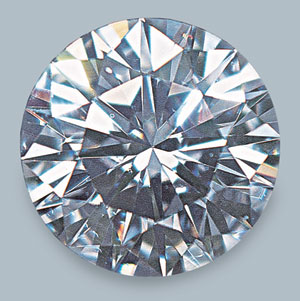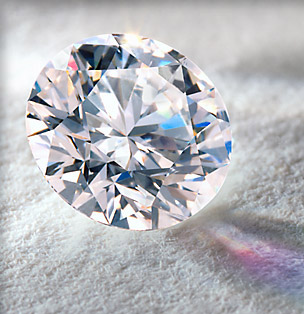April Birthstone
Diamonds

Mohs scale hardness: 10
Diamonds (means "unbreakable" in Greek) are crystallized carbon created under extreme heat and pressure, carbon in its most concentrated form. Diamonds are the hardest substance in nature and the only gemstone composed of a single element. Diamonds are not only hardest gemstone but also the farest light reflected among the gems. Even though diamond is only one level higher on the Moh's scale than corundum, diamond can be anywhere from ten to hundreds of times harder than this class of gems. It is the molecular structure that makes diamonds so hard (carbon atoms linked together in a lattice structure). These transparent crystals are also notable for its high dispersion index and high thermal conductivity. It has been associated with purity and fearlessness since ancient times and, more recently, with love.
Where Do Diamonds Come From
Diamonds formed deep within the earth’s crust (90 miles or about 150 km down) and reach the surface via volcanoes, when magma from far below the surface begins coming up. Once this magma cools, a rock known as kimberlite is formed (the rock which mostly diamonds are found). By the time they reach to the surface of the earth, most of the diamonds are over a billion years old (a diamond could be the oldest material you might own because of this fact). The carbon in diamond may either come from exclusively organic source (called eclogitic diamonds), non-organic source (called harzburgitic diamonds) or a blend of the two. The diamond’s atomic structure gives it the property of being the hardest gemstone, mineral or substance known to man, synthetic or natural. Diamond will preserve its sharp corners and edges even after many years of constant wear while most other gemstones will have become chipped and worn.
What Makes Diamonds So Hard
Diamond structures follow the cubic crystal system, which is very resistant to any further transformation. It is made up of carbon atoms rearanged into tetrahedron shapes, although sometimes hexagonal-shaped diamonds are also found but not as common. Theoretically, an impressive diamond crystal can be composed of only one giant moleculle of carbon. As the most lustrous of true gems, diamonds have a briliant luster and exhibit dazzling color flashes caused by dispersion (also known as “fire”). The dispersion happen when light passes through a diamond and splits into the colors of the spectrum. The ‘brilliant cut’ is the most valuable and preferred cut in diamonds, it is a special cut designed to brinng out the most “fire” in the stone.
Interesting Diamond Facts
Diamonds are probably the most desired gemstones in the world. The diamonds is also used to celebrate the 60th wedding anniversary. The oldest diamond ever found was from India. Diamonds are thought to have been first recognized and mined in India and began its colorful history there, where the gems have been mined and set into jewelry since at least 400 B.C. No other diamonds have generated the mystique and supernatural power equal to that associated with the great diamonds of India's past. When looking for diamonds, think of "5Cs" which is carat, cut, color, clarity and certificate. Although we often think of diamonds as being clear, there are also blue, red, black, pale green, pink and violet diamonds. These natural colored diamonds are the truly rare ones, and thereby can sometimes be the most costly.
However, diamonds are expected to be unbreakable by many people. This is not true. The crystal structure of diamond has ‘soft’ and ‘hard’ directions. A blow of sufficcient force, in a very exact direction, can split, chip, crack or even shatter a diamond. Many synthetic materials are made to resemble diamond, such as cubic zirconia, strontium titanate, synthetic rutile, YAG, moissanite and synthetic spinel. From all of those, zircon is the only natural gemstone which comes closest in luster and fire to diamond, it has a strong double refraction and it is also softer than diamond.
Asian origins: Malaysia, Indonesia, India, Myanmar and Sri Lanka.
Astrologically, diamonds are associated with the zodiac sign of Aries.
April birth flower: Daisy.
Copyright © 2009 Game Frog
Home | Contact | Disclaimer | Privacy Policy